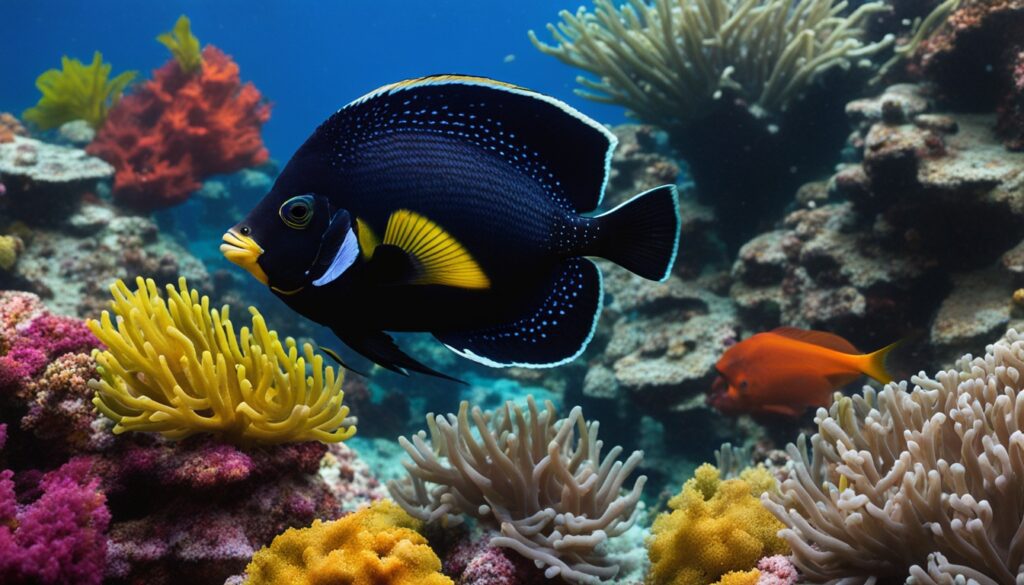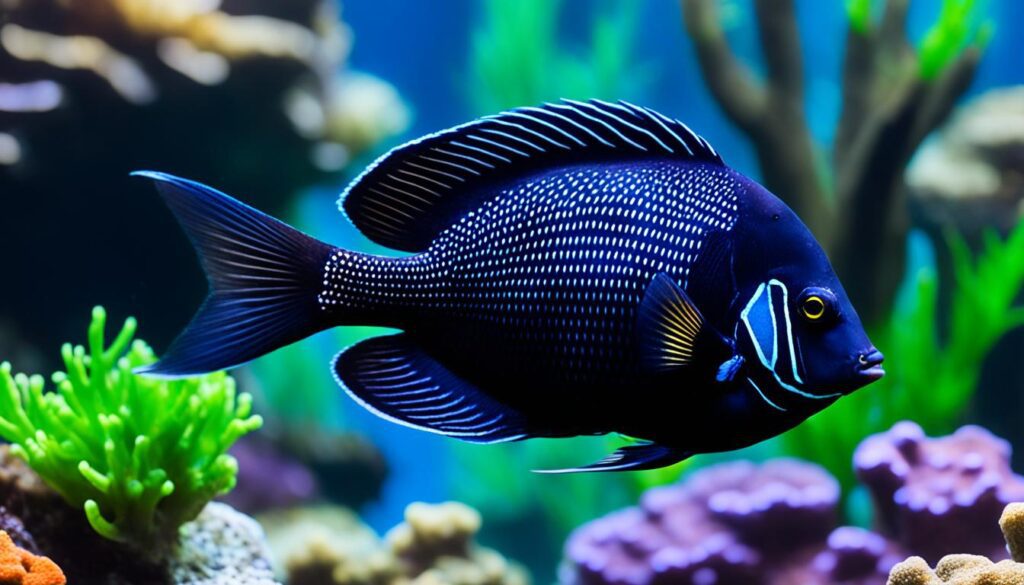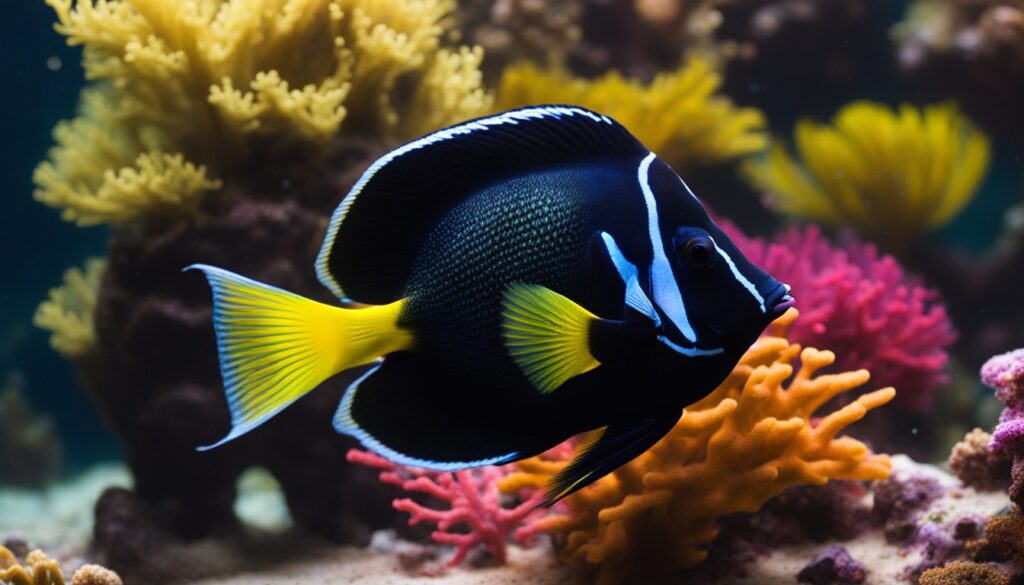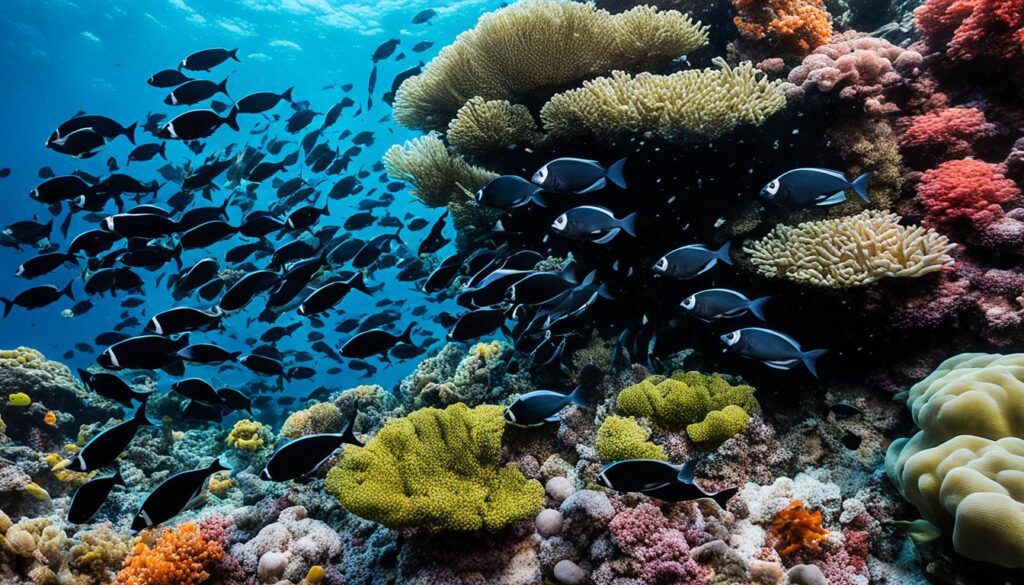I love marine aquariums and the black tang fish is one of my favorite for sure! It’s a beautiful saltwater fish that brings elegance and usefulness to any reef tank. The Zebrasoma rostratum, or Black Longnose Surgeonfish, has a stunning jet-black color with a white diamond mark that grabs your attention.
For those who care for fish, the black tang is absolutely a great choice. It grows to be 8 to 9 inches long but needs a big home. Your aquarium should be at least 180 gallons to keep it happy and show off its beauty. These fish can live for 10 to 15 years, making them great long-term friends for aquarists.
Black tangs are usually peaceful but can be a bit protective of their space, so you should always care about them. When adding them to your reef tank, you must plan ahead. Think about their territorial nature to ensure a harmonious community.
Black Tang (Zebrasoma rostratum) Species Profile

It’s known for its striking jet-black color and graceful moves. This fish is not just a beauty but also a symbol of strength and adaptability.
Characteristics of the Zebrasoma rostratum
The black tang fish catches the eye with its deep black color and elegant fins. Young ones have a brownish-black look that turns richer black as they grow. They often have golden edges on their dorsal and anal fins. This change shows their growth and highlights the need for good fish care.
Black Tang’s Natural Habitat
Black tangs live in the warm waters of the Indo-Pacific coral reef ecosystems. They eat algae, which helps keep the reefs healthy. They live between 3 and 65 feet deep, playing a key role in their coral reef homes.
Rarity and Appeal in Aquaculture
Black tangs are rare in aquaculture, making them highly sought after. Sites like Saltwaterfish.com offer them from sustainable sources. These marine fish are well-suited for life in a saltwater aquarium. They represent responsible marine fish trade and aquaculture.
Fish Type |
Typical Size |
Preferred Habitat |
Feeding Classification |
|---|---|---|---|
Yellow Tang (Zebrasoma flavescens) |
Up to 8 inches |
Shallow reefs |
Herbivore |
Requires 180-gallon tank |
Open, clear waters |
Herbivore, occasional meat |
|
Black Tang (Zebrasoma rostratum) |
Varied sizes up to 9 inches |
Coral reefs |
Primarily algae eater |
Scopas Tang |
Up to 12 inches |
Rugged reefs |
Herbivore |
Each marine fish species adds something special to the marine aquarium. But the black tang is unique, combining mystery and beauty. It’s a top choice for any saltwater aquarium.
Care Guide for Black Tangs

Starting with the best care for your black tang means knowing what they need in a saltwater fish tank. This species is highly valued in the marine aquarium world. They need special attention to their water, temperature, and tank conditions to do well.
Creating the best environment is key for these fish to stay healthy and live longer. Black tangs like water with a pH of 8.1 to 8.4, which matches their ocean home. The salinity should be steady at 1.020-1.025, and the temperature should be between 74 and 78°F (23-26°C). These settings help keep your black tang happy, healthy, and colorful.
Adding black tangs to a community tank needs careful thought. They are peaceful but like their space. Adding them last to your tank helps avoid fights and makes them easier to settle in. This reduces stress and aggression in your tank.
It’s hard to tell black tangs apart by sex, but knowing their behavior helps. This knowledge is useful for breeding and managing them in groups.
If you love saltwater fish, especially black tangs, follow these tips. Your marine friends will not just survive but flourish in their tank. Always get advice from a trusted marine dealer to make sure your fish are healthy and right for your tank.
Setting Up the Perfect Reef Tank for Your Black Tang

Caring for a black tang fish means setting up the right marine aquarium. This guide will help you create a perfect home for your marine fish. We’ll cover tank setup, aquascaping, and keeping water quality top-notch.
Tank Size, Conditions & Requirements
Start with a 120-gallon tank for your black tang fish. They need lots of space to swim and live well. Make sure the tank’s specific gravity is 1.025 and pH levels are between 8.1 and 8.4.
Here are some key points for setting up your tank:
- Choose a 46 Gallon Bowfront System II Aquarium for enough space.
- Use a solid foundation for a big tank like a 120-gallon one. A strong base, like a cement slab, is important to hold the weight.
- Keep the temperature steady between 74°F – 82°F (24°C – 28°C).
Aquascaping for Black Tangs
Aquascaping in a marine aquarium is more than making it look good. It also helps your black tang fish. Place live rock and coral to give them hiding spots and places to eat. This mimics their natural reef home.
- Use both live and dry sand as the tank’s bottom layer. Dry sand is cheaper and will become live over time.
- Live rocks are key for biological filtration and homes for tank creatures. Check them for mantis shrimp, which can be harmful to black tangs.
Filtration and Water Quality
High water quality is crucial for your black tang fish’s health. Change the water often and use good filters to keep it clean. Here’s what you need for the setup:
- Do 50% water changes weekly for the first four weeks to cure the live rock. Then, reduce to 25% as the tank settles.
- A strong filtration system with a protein skimmer keeps the water clear and full of oxygen.
With a well-thought-out tank setup, creative aquascaping, and good water quality, your black tang will do great.
Feeding Habits and Nutrition for Thriving Black Tangs

For saltwater fish like the black tang fish in a saltwater aquarium, it’s not just about looks or tank size. Their health and color depend on knowing their feeding habits and giving them the right food. This is similar to what they eat in the wild.
Marine algae are crucial in the diet of black tangs, showing what they like to eat in nature. Good fish care means giving them food that matches their wild eating habits.
Dietary Staples: Algae and Seaweed Selections
In the wild, black tangs eat various algae. In a saltwater aquarium, giving them high-quality marine algae sheets meets their needs. It also helps prevent health problems like head and lateral line erosion (HLLE). Adding dried seaweed to their diet keeps them colorful and healthy.
Supplemental Feedings: Achieving a Balanced Diet
For a diet like what black tangs eat in the wild, mix marine-based pellets with frozen foods like brine and mysis shrimp. This keeps them healthy and active in your tank. Watching how they react to different foods is key to good fish care. It ensures they eat just the right amount.
Feeding your black tang right is key to their health. By mimicking their wild diet, you help them live longer and better in your saltwater aquarium. This makes your colorful fish thrive in a healthy environment.
Social Disposition and Tank Mate Compatibility of the Black Tang
As a marine aquarium enthusiast, I’ve learned that knowing the social nature of the Black Tang is key for a healthy reef tank. These fish are usually calm but can get territorial in small spaces. Choosing tank mates wisely is crucial because of this.
Research and experience show that Black Tangs can get along with other peaceful fish like damsels. Adding a Black Tang to your tank should be done last to avoid conflicts. For instance, the Naso Tang is also peaceful and can grow up to 18 inches. They need a big tank of at least 180 gallons and stable conditions to live well.
When picking tank mates for the Black Tang, be careful with the Pacific Blue Tang. They might be aggressive towards other tangs. The Pacific Blue Tang needs a big tank of at least 75 gallons and specific conditions to thrive. Their long life and complex care make them a big responsibility.
For a peaceful tank, it’s important to consider each fish’s needs and nature. By doing so, you can create a balanced and calm marine aquarium.








